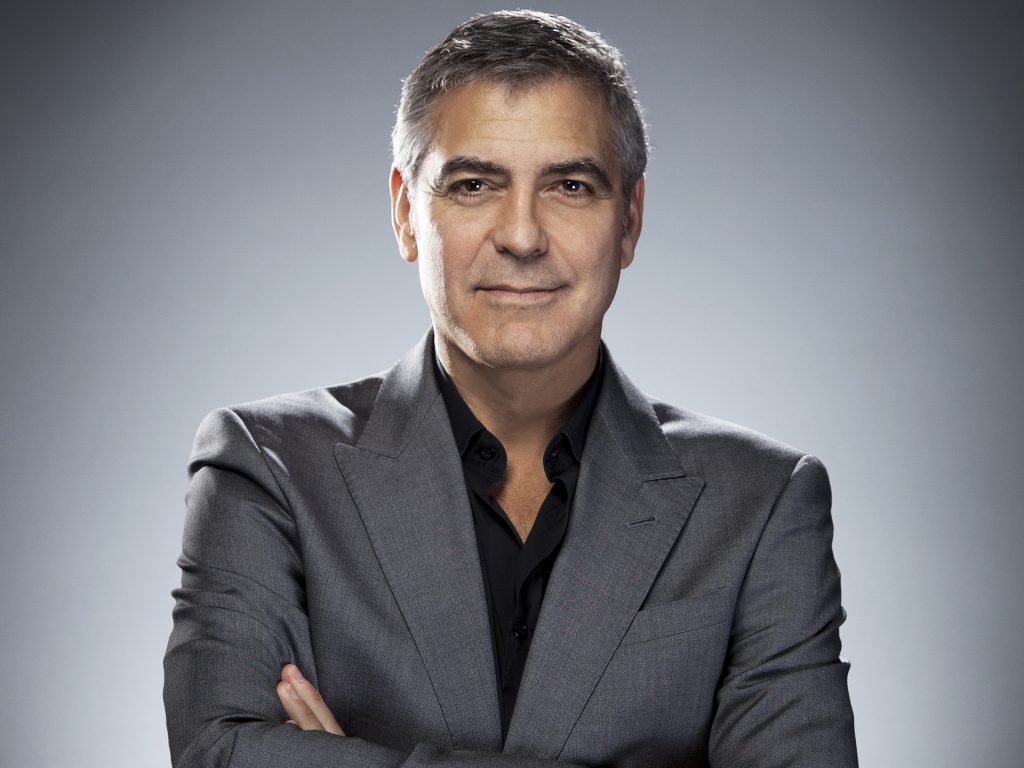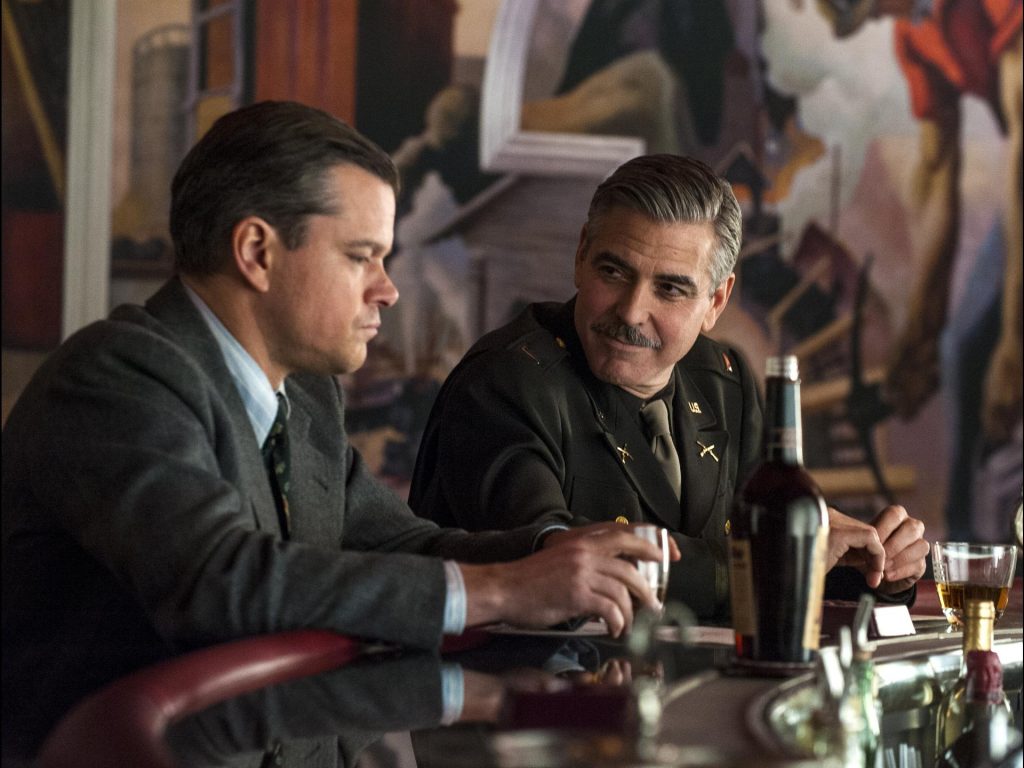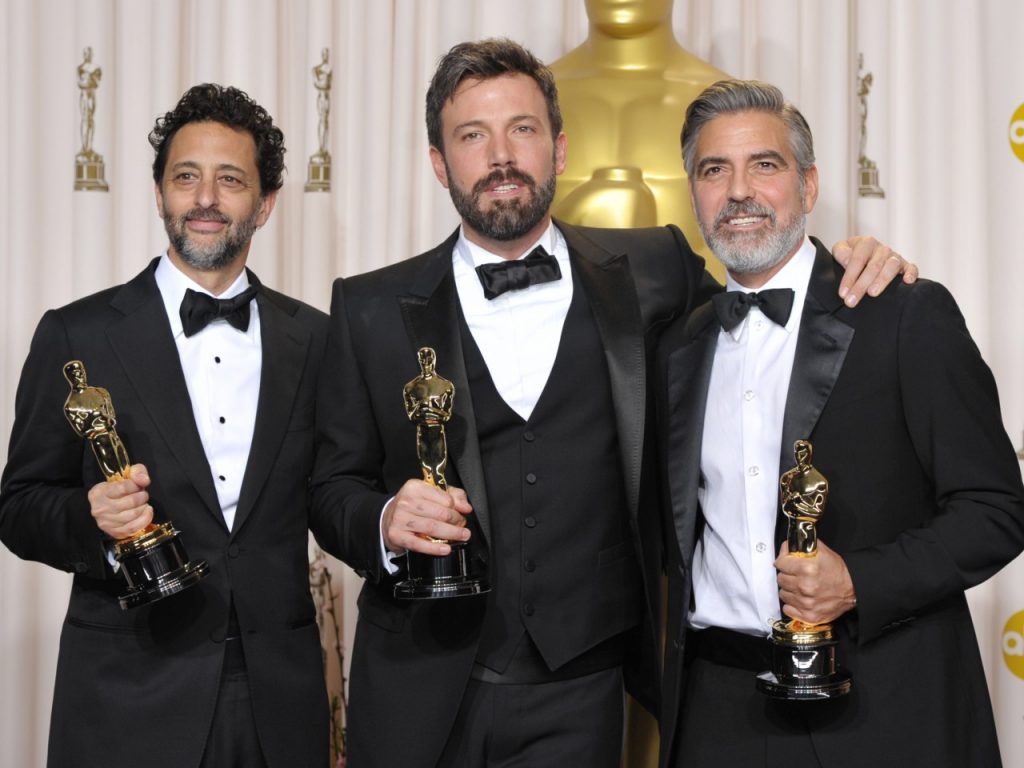No one does the fame thing like Clooney. He floats above it even as he uses it to embellish his influence.
He understands his place in the pantheon even as he remains hidden from the inquisitive lens. He’s the master.
You must love him.
For one thing, he’s lovable, professionally so. For another, he leaves nothing to chance. If he can’t win you over with his fame, his charm, and his good looks, he will win you over with preparation. It’s not that he’s needy, like an actor; it’s that he’s competitive, like an athlete. He’s always been good at making people love him; he’s not about to give up his edge now.
Of course, he is not often challenged, and risks the fate of a fighter whose dominance is tainted by a lack of worthy opponents. A few years ago, however, he lost one of his dogs to a rattlesnake. He is a dog guy—a little sign about men and dogs adorns a living-room wall otherwise dominated by signed photographs of dignitaries—and he set about to get another, preferably hypoallergenic. He saw a black cocker-spaniel mix on the Web site of a rescue organization and called the number. The woman who answered said she’d be happy to bring the dog to his house, but then she explained that the dog had been abandoned and picked up malnourished off the street. “He has to love you,” she told George Clooney, “or else I have to take him back.”
At first, he found himself getting nervous—“freaking out.” What if the dog didn’t love him? Then he responded. “I had some turkey bacon in the refrigerator,” he says. “I rubbed it on me. I’m not kidding. When she came over, the dog went crazy. He was all over me. The woman said, ‘Oh, my God, he’s never like this. Heloves you.’ ”
He has told this story before. He has even told it to Esquire before. That he tells it again—that it’s the first story he tells—serves to announce what is essential about himself: that he’s a man who will do what it takes to win you over, even applying bacon as an unguent.
I have done a few of these things—celebrity profiles—before. I have interviewed famous people in hotel rooms and offices, in bars and in restaurants, even, once, on top of a bridge in Sydney, Australia. Where I have not often interviewed them is at their homes. The home is the turkey bacon of the celebrity profile. It generates, if not love, then at least a sense of gratitude akin to what a dog must feel when allowed on the couch. Leonardo DiCaprio met me in a vast hotel conference room, empty but for an end table and two chairs.
Of course he did. What distinguishes Clooney from other famous people is that he reliably acts as you wish other famous people would act and does what you wish other famous people would do: often the right thing. His house is of a piece with its owner. It might be described as a man-cave writ large. It is slightly undomesticated. You have to climb to get there, up a switchbacked driveway sentried by security cameras and crowded with greenery that he refuses to cut. You can see why he says he does not have many intruders; you can also see why, when he does have intruders, he says, no shit, they usually do their intruding “dressed as trees.”
You do not see all that much of the house, even when you finally summit the driveway, so absorbed is it into its surrounding three acres and the park that begins where the three acres end. What you see is just enough Tudory brick to establish it as a home of Hollywood heritage, and what you see most of all is what welcomes you: the mouth of the three-car garage, open to reveal the only three cars George Clooney could possibly own. There is the gleaming gray Lexus. There is the black Porsche Carrera, sheathed like a sidearm in a black cover. And then there is the 1959 red Corvette convertible, glinting as comically as a hero’s tooth in an old Saturday-afternoon serial. For an idea of Clooney’s pedigree, you need an idea of the Corvette’s: It is original to his family. Clooney’s father, Nick, bought it new, back when he was a radio broadcaster in Lexington, Kentucky. George grew up with it as one of the family cars, and it now has pride of place as a sort of Playboy Philosophy on wheels.
Beyond the garage stands the wooden front door, massive, slablike, arched, trellised with vines, and battering-ram resistant. To say that they don’t make doors like that anymore is to understate the case; they don’t maketrees like that anymore. Some mogul must have ditched what was left of his soul for that door, and now it gives the house the stately air of a ruin behind which might very well lurk Gloria Swanson. And yet when it opens, there stands Clooney’s assistant, Angel, and when she walks through the dark-wood-and-leather shadows of the house to the kitchen, there stands her boss, trying to make a cup of coffee on a machine he’s forgotten how to use.
He has been traveling a lot lately. He has been working a lot lately, more, in fact, than he has in a long time: as one of the stars of Gravity, as the director and leading man of The Monuments Men, as the producer of August: Osage County, and as the eminence of a new movie he’s been filming in Vancouver called Tomorrowland. His parents were also just in town. No matter: He’s instantly, helplessly affable, his handshake offered as forthrightly as the handle in an old voting booth. He ekes out a coffee, makes himself a tea, and takes a seat on the couch in his living room, with a large-screen TV broadcasting NFL highlights from the mantel of a stone fireplace, and the high peaked ceiling crossed by rough-hewn timbers apparently salvaged from the Fortress of Solitude after Superman decided to modernize. His dog, Einstein, squeezes in next to him; when his iPhone rings, Clooney, without answering, immediately turns it off.
 He is fifty-two years old. He is wearing a black hoodie zipped to the neck, blue jeans, and boots laced so assertively they squeak when he flexes his ankles. He has a long neck, upon which his long head, adorned by long ears, wobbles like a tulip. Everything is to scale with him. Many people have long eyelashes; he has lashes as long on the bottom as they are on the top. His eyes look like they’ve been caught by Venus flytraps. He is going gray, yes, but if you took a population sample of his hair, there is no doubt that any analysis would reveal that the numbers of black and gray hairs are evenly distributed and have achieved equipoise. He has recently showered, and a careful modicum of product lifts his hair off his forehead. He has surprisingly fine hands. He smells like soap.
He is fifty-two years old. He is wearing a black hoodie zipped to the neck, blue jeans, and boots laced so assertively they squeak when he flexes his ankles. He has a long neck, upon which his long head, adorned by long ears, wobbles like a tulip. Everything is to scale with him. Many people have long eyelashes; he has lashes as long on the bottom as they are on the top. His eyes look like they’ve been caught by Venus flytraps. He is going gray, yes, but if you took a population sample of his hair, there is no doubt that any analysis would reveal that the numbers of black and gray hairs are evenly distributed and have achieved equipoise. He has recently showered, and a careful modicum of product lifts his hair off his forehead. He has surprisingly fine hands. He smells like soap.
The day before, he gave a eulogy at the memorial service for his uncle, Dante DiPaolo. Uncle Dante was married to his Aunt Rosemary—the late great American singer.
“I loved the guy,” Clooney says. “I got along with him a lot better than I got along with Aunt Rosie, that’s for sure. He was one of those guys who’d pull you over at a party and give you a few bucks—‘Here’s a little scratch; go and have a good time.’ I held his hand when he died. He was a professional dancer—you know, a real hip dude. But the memorial service was so reverential. So when I got up there, I said, ‘You know, I’m looking around at you people, and I’m reminded of Dante getting on the plane with Aunt Rosemary in the seventies, coming back from Rosemary playing the London Palladium. Some band member had given him a ball of hash. And Rosemary said, “What did you do with the hash?” And he goes, “I’ve got it right here in my bag!” And she’s like, “Are you out of your mind? We’re on a plane! Get over there and flush that down the toilet!” And he’s like, “Aw, c’mon, Rosie. Flush it down the toilet?” And he goes to the back of the airplane, and when he comes back she says, “Did you flush it down the toilet?” And he says, “No.” And she says, “What did you do with it?” And he goes, “I ate it!” He spent the next twelve hours stoned. They carried him off the plane.’
“A lot of people laughed. But there were a lot of older people there, and there was this moment where they looked like they could have been offended, because here it’s a memorial and we’re talking about hash. And I just went, ‘Every single one of you was in a band. All of you were dancers and actors. And all of this stuff was stuff that you talked about and did!’ ”
On the walls of Clooney’s home, there are a lot of photographs from powerful people, such as President Obama, who have written him in friendship and in gratitude. There is also a framed selection of neckties that once belonged to one powerful person in particular, John F. Kennedy. There are also many striking black-and-white photographs of Dino and Sammy horsing around in tuxedos. They go with the bar, which is arrayed with a swank skyline of liquors and cordials and on which is perched the figure of the fox that Wes Anderson used for the stop-motion animation of Fantastic Mr. Fox—Clooney was Mr. Fox; Mr. Fox was Clooney.
And then, near the front door, there is the most important artifact in a house that is both full of them and, in its own right, artifactual. It’s an old piece of tile, white, with some words baked on it in black. The rest of the stuff on Clooney’s walls, well, as he says, “You gotta remember that part of my life is people give me things and I put them on the wall, right?” He knew Sammy and Dean, a little; he knew them as a kid, growing up Rosie’s nephew, but even those photos came to him as gifts—“I think I was given all of them during theOcean’s period. And I like the photos, so I put them on the wall because I thought they were cool and they were fun, but I don’t think and live and breathe the Rat Pack life.”
The tile is different. The tile he found after he bought the house in 1995, with ER money. A former owner left it behind. On it is written the house’s street number. And over the address, in paint-brushed print of aching domesticity, it says THE GABLES.
Now, a lot of people, friends included, call George Clooney a throwback. He is a throwback to what they suppose was a different time that created a different kind of celebrity. A lot of people even call him the closest thing we have to Clark Gable, a mantle he has accepted to the extent that he replicated Gable’s rhythms and timing for O Brother, Where Art Thou? and sports a Gablean ’stache in The Monuments Men. But there are a lot of throwbacks in this world. George Clooney is the only throwback who lives in Clark Gable’s freaking house.













